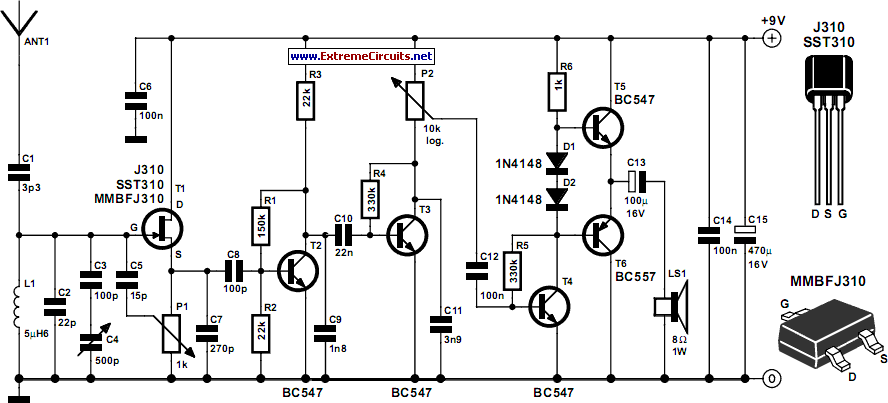

It is avery wonderful circuit.and it is very simpal for new electronic field commers. i have not tried the radio on 220-400 mhz. otherwise you will have problems getting the radio to work. when you are building this receiver keep all the leads as short as possible. This radio is a very well built project it is very stable. Where is audio out and power in? Can someone confirm my observation before I build this scanner?ġ-(+) positive side of microphone or speaker tap in at base of Q1 between C3 and C6.Ģ-(-) Negative of speaker tap in at Q1 emitter at top of L2.ģ-Power in at top of C5, power out to positive at R2 at +9V You can obtain a 2N918 transistior from mouser electronics web site a MPS2222A transistor will only work on air band 117-137 mhz not 220-400mhz.Ī more common subsistute for 2N918 would be nice.Īlso the diode seems to be connected in reversed bias. How can we change the range of this radio to 118~137MHz?Ĭan I replace diode 1N82 for 1N60? If no, what diode can I replace 1N82? Its really fantastic opertunity to see this circuit & to create it

A normal silicon diode will not work well as a Germanium diode has a 0.3V forward drop and a silicon diode has a 0.7V forward drop.įor air band i am using a 3.5 turn coil of wire on a 3/8 in. My research indicates that the 1N82 is a germanium diode from the fifties. I built it and works! I replaced 2n918 with a 9018 with a frequency transition of 1100 mhz! I made L2 with 28 turns of 0,6 mm wire on 7mm drill bit, 1.6 cm long. Do you have any comments about these replaces?. I biuld this circuit but I receive no signal (yet). I'm not sure what else may need to be changed at this point to accommodate the higher frequencies. I like the circuit on the above website, but the values of the coil and tuning cap need to be changed to tune the newer air band. The ideas of using a front end buffer and an audio amp stage can help this type of receiver circuit quite a bit. It's in the Czech language, but you can translate it and the schematic does not need any translation. The 2N3904 transistor will work fine in the audio stage, however. One thing I forgot to mention in my previous comment was that the 2N3904 transistor will not work at 400MHz, but the SF245 transistor used in the Czech circuit will. If they are not to far away my call is k6cal I am in San Jose CA I have a gmrs twoway radio it keys from 110.9 to MHz. In the schematic is the 1N82 diode in correct orientation? Cathode towards C8?Īircraft communicationAircraft Radio Communications Receiver I do want to build a second for the 108-135megahertz commercial/civilian aircraft band.what would be the coil for this conversion and what would be the capacitor value for the emitter to collector? There is alot of military aircraft traffic here so I should be able to use it alot.
#ALL BAND RECEIVER RADIO CIRCUIT SERIES#
I am getting ready to build this radio,I am using a 0-60pf variable cap with a 22pf in series to bring it down to the 15pf as shown in the schematic. The antenna can also be placed at the anode of D1 if overload is a problem with it connected to the emitter of Q1ģ Watt FM Transmitter, 8 Watt Audio Amp, 22 Watt Audio Amplifier, 50 Watt Amplifier, Crystal Radio, FM Transmitter, Guitar Fuzz Effect, FET Audio Mixer, Microphone Mixer, 8 Note Tune Player, Op Amp Radio, Mono To Stereo Synthesizer, Electronic Stethoscope, Tone Control, Transistor Organ, Stereo Tube Amplifier, Digital Volume Control, Sound Level Meter, Aircraft Radio Communications Receiver, Single Chip FM Radio, One Tube Regenerative Radio, Single Chip AM RadioĬan this be modified to listen to spacecraft communications from the International Space Station and Soyuz spacecraft?.This inductor can be modified to shift the frequency range of the circuit. L1 is made by winding 2 turns of 22 AWG magnet wire on a 5/32 drill bit.The circuit originally appeared in the Think Tank column of the Sept.With an easy to build circuit such as this one, everyone can enjoy listening in on these conversations. And scanners can be complicated, large and expensive. However radios that receive the approximately 220MHz to 400MHz band commonly used for aircraft (both military and commercial) are not easily found. The communications between commercial aircraft and the ground can be interesting, amusing and sometimes even disturbing.


 0 kommentar(er)
0 kommentar(er)
